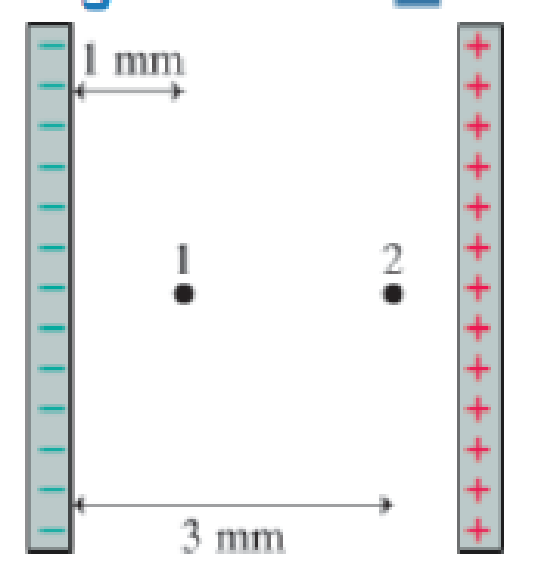
Modified Mastering Physics with Pearson eText -- Standalone Access Card -- for College Physics: A Strategic Approach (4th Edition)
4th Edition
ISBN: 9780134724744
Author: Randall D. Knight (Professor Emeritus), Brian Jones, Stuart Field
Publisher: PEARSON
expand_more
expand_more
format_list_bulleted
Concept explainers
Textbook Question
Chapter 21, Problem 8CQ
Figure Q21.9 shows two points inside a capacitor. Let V = 0 V at the negative plate.
Figure Q21.9

A. What is the ratio V2/V1 of the electric potential at these two points? Explain.
B. What is the ratio E2/E1 of the electric field strength at these two points? Explain.
Expert Solution & Answer
Want to see the full answer?
Check out a sample textbook solution
Students have asked these similar questions
Please solve this problem and give step by step explanations on each step while breaking it down please. Thank you!!
Please solve this problem and give step by step explanations on each step while breaking it down please. Thank you!!
No chatgpt pls
Chapter 21 Solutions
Modified Mastering Physics with Pearson eText -- Standalone Access Card -- for College Physics: A Strategic Approach (4th Edition)
Ch. 21 - By moving a 10 nC charge from point A to point B,...Ch. 21 - Charge q is fired through a small hole in the...Ch. 21 - Prob. 3CQCh. 21 - Prob. 4CQCh. 21 - An electron moves along the trajectory from i to f...Ch. 21 - As shown in Figure Q21.7, two protons are launched...Ch. 21 - Prob. 7CQCh. 21 - Figure Q21.9 shows two points inside a capacitor....Ch. 21 - A capacitor with plates separated by distanced is...Ch. 21 - Prob. 10CQ
Ch. 21 - Prob. 11CQCh. 21 - Prob. 12CQCh. 21 - Prob. 13CQCh. 21 - Prob. 14CQCh. 21 - Prob. 15CQCh. 21 - Prob. 17CQCh. 21 - Prob. 18MCQCh. 21 - A 1.0 nC positive point charge is located at point...Ch. 21 - Prob. 20MCQCh. 21 - Prob. 21MCQCh. 21 - Prob. 22MCQCh. 21 - Prob. 23MCQCh. 21 - Prob. 24MCQCh. 21 - Prob. 25MCQCh. 21 - Prob. 26MCQCh. 21 - A bug zapper consists of two metal plates...Ch. 21 - An atom of helium and one of argon are singly...Ch. 21 - Prob. 29MCQCh. 21 - Prob. 30MCQCh. 21 - Prob. 31MCQCh. 21 - Prob. 32MCQCh. 21 - Moving a charge from point A, where the potential...Ch. 21 - The graph in Figure P21.2 shows the electric...Ch. 21 - It takes 3.0 J of work to move a 15 nC charge from...Ch. 21 - Prob. 4PCh. 21 - A 20 nC charge is moved from a point where V = 150...Ch. 21 - Prob. 6PCh. 21 - At one point in space, the electric potential...Ch. 21 - Prob. 8PCh. 21 - What potential difference is needed to accelerate...Ch. 21 - Prob. 10PCh. 21 - An electron with an initial speed of 500,000 m/s...Ch. 21 - Prob. 12PCh. 21 - A proton with an initial speed of 800,000 m/s is...Ch. 21 - The electric potential at a point that is halfway...Ch. 21 - A 2.0 cm 2.0 cm parallel-plate capacitor has a...Ch. 21 - Two 2.00 cm 2.00 cm plates that form a...Ch. 21 - Prob. 18PCh. 21 - Prob. 19PCh. 21 - Prob. 20PCh. 21 - Prob. 21PCh. 21 - Prob. 22PCh. 21 - a. What is the potential difference between the...Ch. 21 - Prob. 24PCh. 21 - Prob. 25PCh. 21 - Prob. 26PCh. 21 - Prob. 27PCh. 21 - Prob. 28PCh. 21 - Prob. 29PCh. 21 - Prob. 30PCh. 21 - What are the magnitude and direction of the...Ch. 21 - Prob. 32PCh. 21 - Prob. 33PCh. 21 - Prob. 34PCh. 21 - Prob. 35PCh. 21 - Prob. 36PCh. 21 - Two 2.0 cm 2.0 cm square aluminum electrodes,...Ch. 21 - Prob. 38PCh. 21 - An uncharged capacitor is connected to the...Ch. 21 - Prob. 40PCh. 21 - You need to construct a 100 pF capacitor for a...Ch. 21 - Prob. 42PCh. 21 - A switch that connects a battery to a 10 F...Ch. 21 - Prob. 44PCh. 21 - Initially, the switch in Figure P21 .33 is open...Ch. 21 - A 1.2 nF parallel-plate capacitor has an air gap...Ch. 21 - A 25 pF parallel-plate capacitor with an air gap...Ch. 21 - Prob. 48PCh. 21 - A science-fair radio uses a homemade capacitor...Ch. 21 - A parallel-plate capacitor is connected to a...Ch. 21 - A parallel-plate capacitor is charged by a 12.0 V...Ch. 21 - Prob. 52PCh. 21 - To what potential should you charge a 1.0 F...Ch. 21 - Prob. 54PCh. 21 - Capacitor 2 has half the capacitance and twice the...Ch. 21 - Prob. 56PCh. 21 - 50 pJ of energy is stored in a 2.0 cm 2.0 cm 2.0...Ch. 21 - Two uncharged metal spheres, spaced 15.0 cm apart,...Ch. 21 - A 2.0-cm-diameter parallel-plate capacitor with a...Ch. 21 - Prob. 60GPCh. 21 - A 50 nC charged particle is in a uniform electric...Ch. 21 - The 4000 V equipotential surface is 10.0 cm...Ch. 21 - Prob. 63GPCh. 21 - Two point charges 2.0 cm apart have an electric...Ch. 21 - A +3.0 nC charge is at x = 0 cm and a 1.0 nC...Ch. 21 - A 3.0 nC charge is on the x-axis at x = 9 cm and a...Ch. 21 - Prob. 67GPCh. 21 - Electric outlets have a voltage of approximately...Ch. 21 - A Na+ion moves from inside a cell, where the...Ch. 21 - Suppose that a molecular ion with charge 10e is...Ch. 21 - Prob. 71GPCh. 21 - a. What is the electric potential at point A in...Ch. 21 - Prob. 73GPCh. 21 - A proton follows the path shown in Figure P21.63....Ch. 21 - A parallel-plate capacitor is charged to 5000 V. A...Ch. 21 - A proton is released from rest at the positive...Ch. 21 - In the early 1900s, Robert Millikan used small...Ch. 21 - Two 2.0-cm-diameter disks spaced 2.0 mm apart form...Ch. 21 - In proton-beam therapy, a high-energy beam of...Ch. 21 - A 2.5-mm-diameter sphere is charged to 4.5 nC. An...Ch. 21 - A proton is fired from far away toward the nucleus...Ch. 21 - Prob. 82GPCh. 21 - Prob. 83GPCh. 21 - A capacitor consists of two 6.0-cm-diameter...Ch. 21 - The dielectric in a capacitor serves two purposes....Ch. 21 - The highest magnetic fields in the world are...Ch. 21 - The flash unit in a camera uses a special circuit...Ch. 21 - A Lightning Strike Storm clouds build up large...Ch. 21 - Prob. 89MSPPCh. 21 - A Lightning Strike Storm clouds build up large...Ch. 21 - A Lightning Strike Storm clouds build up large...Ch. 21 - A Lightning Strike Storm clouds build up large...
Additional Science Textbook Solutions
Find more solutions based on key concepts
How does an obligate aerobe differ from a facultative aerobe?
Brock Biology of Microorganisms (15th Edition)
Explain the role of gene flow in the biological species concept.
Campbell Biology (11th Edition)
Which compound is more easily decarboxylated?
Organic Chemistry (8th Edition)
27. Consider the reaction.
Express the rate of the reaction in terms of the change in concentration of each of...
Chemistry: Structure and Properties (2nd Edition)
Match each of the following items with all the terms it applies to:
Human Physiology: An Integrated Approach (8th Edition)
Flask A contains yeast cells in glucose-minimal salts broth incubated at 30C with aeration. Flask B contains ye...
Microbiology: An Introduction
Knowledge Booster
Learn more about
Need a deep-dive on the concept behind this application? Look no further. Learn more about this topic, physics and related others by exploring similar questions and additional content below.Similar questions
- No chatgpt plsarrow_forwardCar A starts from rest at t = 0 and travels along a straight road with a constant acceleration of 6 ft/s^2 until it reaches a speed of 60ft/s. Afterwards it maintains the speed. Also, when t = 0, car B located 6000 ft down the road is traveling towards A at a constant speed of 80 ft/s. Determine the distance traveled by Car A when they pass each other.Write the solution using pen and draw the graph if needed.arrow_forwardIn the given circuit the charge on the plates of 1 μF capacitor, when 100 V battery is connected to the terminals A and B, will be 2 μF A 1 µF B 3 µFarrow_forward
- The velocity of a particle moves along the x-axis and is given by the equation ds/dt = 40 - 3t^2 m/s. Calculate the acceleration at time t=2 s and t=4 s. Calculate also the total displacement at the given interval. Assume at t=0 s=5m.Write the solution using pen and draw the graph if needed.arrow_forwardThe velocity of a particle moves along the x-axis and is given by the equation ds/dt = 40 - 3t^2 m/s. Calculate the acceleration at time t=2 s and t=4 s. Calculate also the total displacement at the given interval. Assume at t=0 s=5m.Write the solution using pen and draw the graph if needed.arrow_forwardThe velocity of a particle moves along the x-axis and is given by the equation ds/dt = 40 - 3t^2 m/s. Calculate the acceleration at time t=2 s and t=4 s. Calculate also the total displacement at the given interval. Assume at t=0 s=5m.Write the solution using pen and draw the graph if needed. NOT AI PLSarrow_forward
- The velocity of a particle moves along the x-axis and is given by the equation ds/dt = 40 - 3t^2 m/s. Calculate the acceleration at time t=2 s and t=4 s. Calculate also the total displacement at the given interval. Assume at t=0 s=5m.Write the solution using pen and draw the graph if needed.arrow_forwardThe velocity of a particle moves along the x-axis and is given by the equation ds/dt = 40 - 3t^2 m/s. Calculate the acceleration at time t=2 s and t=4 s. Calculate also the total displacement at the given interval. Assume at t=0 s=5m.Write the solution using pen and draw the graph if needed.arrow_forwardPlease don't use Chatgpt will upvote and give handwritten solutionarrow_forward
- No chatgpt pls will upvote Already got wrong chatgpt answerarrow_forwardAn electron and a proton are each accelerated through a potential difference of 21.0 million volts. Find the momentum (in MeV/c) and the kinetic energy (in MeV) of each, and compare with the results of using the classical formulas. Momentum (MeV/c) relativistic classical electron proton Kinetic Energy (MeV)arrow_forwardFour capacitors are connected as shown in the figure below. (Let C = 20.0 µF.) (a) Find the equivalent capacitance between points a and b. µF (b) Calculate the charge on each capacitor, taking ΔVab = 14.0 V. 20.0 µF capacitor µC 6.00 µF capacitor µC 3.00 µF capacitor µC capacitor C µCarrow_forward
arrow_back_ios
SEE MORE QUESTIONS
arrow_forward_ios
Recommended textbooks for you
 Physics for Scientists and Engineers, Technology ...PhysicsISBN:9781305116399Author:Raymond A. Serway, John W. JewettPublisher:Cengage Learning
Physics for Scientists and Engineers, Technology ...PhysicsISBN:9781305116399Author:Raymond A. Serway, John W. JewettPublisher:Cengage Learning Physics for Scientists and Engineers: Foundations...PhysicsISBN:9781133939146Author:Katz, Debora M.Publisher:Cengage Learning
Physics for Scientists and Engineers: Foundations...PhysicsISBN:9781133939146Author:Katz, Debora M.Publisher:Cengage Learning Principles of Physics: A Calculus-Based TextPhysicsISBN:9781133104261Author:Raymond A. Serway, John W. JewettPublisher:Cengage Learning
Principles of Physics: A Calculus-Based TextPhysicsISBN:9781133104261Author:Raymond A. Serway, John W. JewettPublisher:Cengage Learning College PhysicsPhysicsISBN:9781305952300Author:Raymond A. Serway, Chris VuillePublisher:Cengage Learning
College PhysicsPhysicsISBN:9781305952300Author:Raymond A. Serway, Chris VuillePublisher:Cengage Learning College PhysicsPhysicsISBN:9781285737027Author:Raymond A. Serway, Chris VuillePublisher:Cengage Learning
College PhysicsPhysicsISBN:9781285737027Author:Raymond A. Serway, Chris VuillePublisher:Cengage Learning College PhysicsPhysicsISBN:9781938168000Author:Paul Peter Urone, Roger HinrichsPublisher:OpenStax College
College PhysicsPhysicsISBN:9781938168000Author:Paul Peter Urone, Roger HinrichsPublisher:OpenStax College

Physics for Scientists and Engineers, Technology ...
Physics
ISBN:9781305116399
Author:Raymond A. Serway, John W. Jewett
Publisher:Cengage Learning

Physics for Scientists and Engineers: Foundations...
Physics
ISBN:9781133939146
Author:Katz, Debora M.
Publisher:Cengage Learning

Principles of Physics: A Calculus-Based Text
Physics
ISBN:9781133104261
Author:Raymond A. Serway, John W. Jewett
Publisher:Cengage Learning

College Physics
Physics
ISBN:9781305952300
Author:Raymond A. Serway, Chris Vuille
Publisher:Cengage Learning

College Physics
Physics
ISBN:9781285737027
Author:Raymond A. Serway, Chris Vuille
Publisher:Cengage Learning

College Physics
Physics
ISBN:9781938168000
Author:Paul Peter Urone, Roger Hinrichs
Publisher:OpenStax College
Physics Capacitor & Capacitance part 7 (Parallel Plate capacitor) CBSE class 12; Author: LearnoHub - Class 11, 12;https://www.youtube.com/watch?v=JoW6UstbZ7Y;License: Standard YouTube License, CC-BY